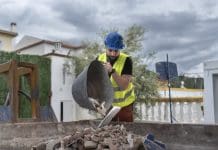The Geospatial Commission has launched a new digital map that will change the way underground pipes and cables and installed, maintained, and repaired
The digital map, called the National Underground Asset Register (NUAR), uses data from the public and private sector organisations that own pipes and cables in northeast England, Wales, and London.
It is estimated that there are around four million kilometres of buried pipes and cables in the UK, and a new hole is dug every seven seconds to install, fix, maintain or repair them. These pipes and cables are vital for the supply of water, gas, and electricity, as well as telecommunications.
There are over 650 asset owners in both public and private sectors who hold data about their own assets, which are required to be shared by law in order to adhere to ‘safe digging’ standards. However, there are currently no standardised methods for sharing this information.
What information does the digital map contain?
NUAR is a government-led comprehensive data-sharing platform detailing the location and condition of underground assets. The purpose of the platform is to streamline the data-sharing process, reduce the risk of potentially lethal utility asset strikes and improve the efficiency and management and maintenance of underground assets.
The map details all of the major energy and water providers, including Northumbrian Water, Wales and West Utilities, Southern Electric Power Distribution and National Grid, as well as smaller providers. NUAR also includes data on telecommunications companies, transport organisations and local authorities.
“The government’s National Underground Asset Register will transform how the UK manages its buried infrastructure. This first step towards UK-wide access, starting in northeast England, Wales and London, has been achieved through strong collaboration between government and industry and the ingenuity of the programme team in the Geospatial Commission,” said Viscount Camrose, parliamentary under-secretary of state for the Department for Science, Innovation and Technology.
This first phase of the project, known as the ‘minimum viable product’ (MVP), is available to eligible organisations in the three areas. NUAR has been designed to complement current business practices and enable users to plan for future adoption and will provide feedback that will further enhance the service.
NUAR can lead to economic growth
The digital map aims to improve efficiency in construction and development, reduce disruption to the public and businesses and improve safety for workers. It is estimated that NUAR could deliver over £350m of economic growth per year.
“This first release of NUAR is a major milestone in a programme that will benefit everyone. By using the power of location data to plan and deliver street works more effectively, it will improve the efficiency with which we supply essential services, and it will minimise the disruption experienced by other road users,” said Dr Steve Unger, independent commissioner at Geospatial Commission.
“Many different asset types are buried beneath our feet, owned by many different organisations, large and small. We are delighted by the number of asset owners that have recognized the value of working with us to make the data that they hold more accessible,” continued Dr Unger.
The ability to be able to virtually search for all available assets before excavating for a gas or water leak or other similar urgent works puts the operatives in a far superior position to aid in their avoidance of damaging underground assets,” concluded Colin Sawkins, assurance and an enabling specialist at Cadent Gas Limited.














